
Nick goes way off the beaten track in Argentine Patagonia.
“Have you seen my puppy? He’s been lost somewhere down the river all day!” Ilda asked us in Spanish.
Ilda was a grandmother, her brown skin wrinkled from a life in the sun. She wore a denim shirt and a red bandana around her neck. Her hair was jet-black and she had a serious face, but a bright, girlish smile that belied her years. There were a couple of lean and dusty dogs by her side. She ran a basic angler’s camp at her homestead in the Mapuche indigenous reservation in Argentina. It was called El Manzanito - the little apple.
The camp was right on the banks of the Rio Malleo, one of the most famous dry fly rivers in Patagonia. It is a small lake-fed stream, snaking through a narrow, arid valley. Away from the water, the hillsides were mostly covered in golden tussocks with a few squat desert shrubs and scattered outcrops of reddish rock. It had been a long hot summer, and now the river was very low, and the leaves on the willow trees which lined it were showing the first hints of autumn.
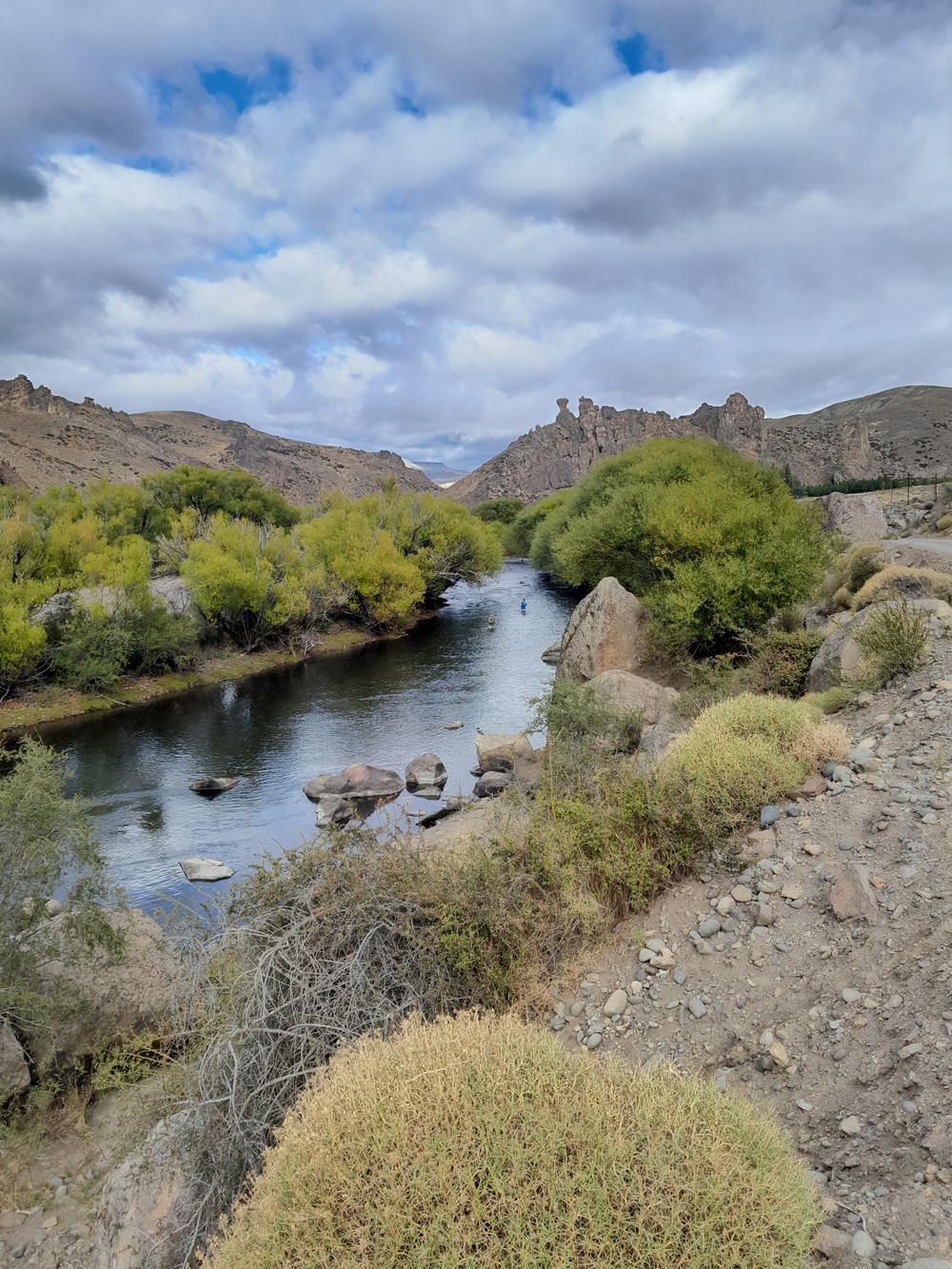
We promised Ilda that we’d keep an eye out for her puppy, then drove to the water’s edge to put up our tents. The only others staying in the camp were two middle-aged Argentinian flyfishers. Mauro and César were tall and heavy, with stern expressions under mops of dark hair, but quick to break into a smile or joke.
My buddy Carter speaks great Spanish and got chatting to Mauro. Carter is just 22 years-old, but earnest and respectful, and they immediately took a liking to him. Mauro was soon telling him where the best fishing spots were, and invited us to fish the evening rise with him. Carter jumped into the shiny black truck with this complete stranger, and they roared off down the stony dirt road to where the Rio Malleo flowed into the much larger Rio Aluminé, while I stayed to set up camp.
I was driving tent pegs into the sandy ground while keeping one eye on César, who had wandered down to the water’s edge for a flick. He was standing in the one good spot. It still seemed a bit early for the evening rise, and he only got a few little ones. I strung up my rod with a small Adams and sidled in downstream of him. Tiny trout were rising in front of me. Some quick movements caught my eye, and I watched a mink hunting through the willows on the far bank, its black coat contrasting with the dry willow branches. The light started to change and as trout began to rise more regularly, and I really wanted to edge into César’s water. Just when I thought I couldn’t take it any longer César abruptly wound in his line and walked back to his camp, where a campfire was soon burning. I took over his spot, casting to the deeper water around the base of a willow on the far bank. I got four little rainbows before I made a long cast and pulled out the best fish, a brown of 14 inches, right on dusk.
Mauro and Carter returned just on dark. It had been windy down on the big river, without much of an evening rise, but Carter had still caught two 13 inch ‘bows, one on a stonefly nymph and one on an emerger. Best of all, he told me we were invited to join our neighbours for their barbeque or Asado.
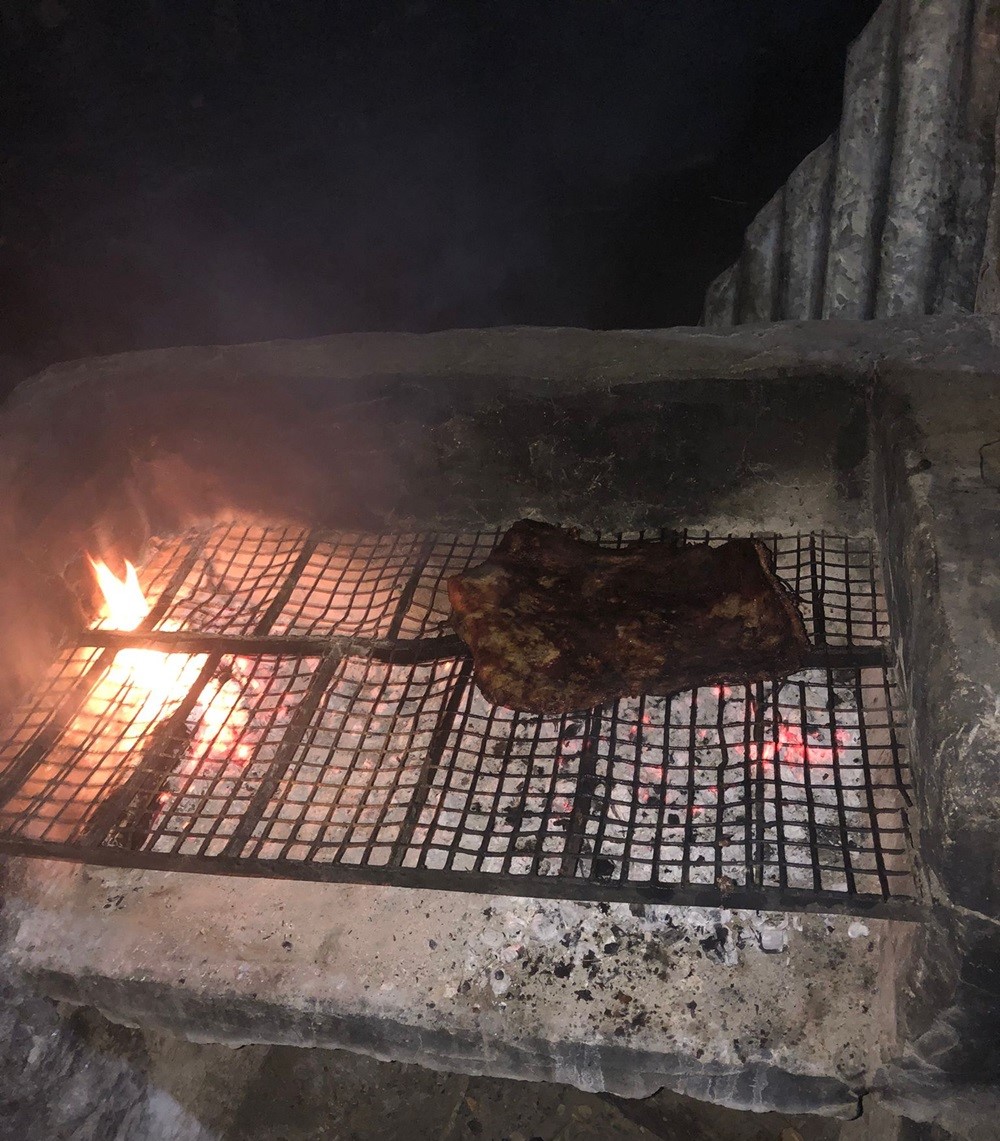
When the fire had burnt down to embers, Mauro placed a slab of beef on the grill above it. This was a matambre, or beef flank steak, a foot long and three inches thick. He cooked this Argentine specialty to perfection, nicely charred on the outside and still pink on the inside. Their malbec wine tasted sweet and deliciously indulgent after the heat of the day. Mauro was the raconteur of the pair, telling bawdy jokes, while his best mate César was quietly competent. They were regulars here, and tomorrow they were off to float the Rio Collón Curá with a guide. This was a river in the pampa, that vast dry desert of grass which covers much of Patagonian Argentina. The river had looked wide and too warm on our drive here from Bariloche, but they assured us that it was full of trout. They were great company, and we finally turned in around 11pm. I fell asleep to the quiet murmur of the river, excited for the next day’s fishing.
Day Two
We awoke to the crowing of roosters. It had been very windy overnight, and the fine pale dust from the bare ground had made its way inside our tents. Chickens were scratching around in the dust outside. Now I understood and appreciated the shelter made of rough-sawn timber, with black plastic stretched over the gaps in the planks and went in there to prepare breakfast. Two dogs had slept in there, out of the wind. They were still curled up in perfect circles, their long bushy tails covering their eyes. They didn’t beg, only watching us intently as we prepared breakfast, and I was careful to keep the food up on the picnic table, safely out of their reach. But I hadn’t counted on the chickens. When I walked away for a moment, they mobbed the table, attacking my bowl of oats and even tipping over my cup of tea. They had looked so innocent scratching around outside the shelter, but this was just a cover act – these birds were practiced thieves.
It was calm now, so we chose to fish the Rio Aluminé first as it lay in a wide and exposed valley, with little riparian vegetation to shelter it once the winds of the pampa got up. We drove to the confluence of the two rivers and turned upstream to follow the Aluminé along its true right bank. The river was large and deep, fifty metres wide, with pools hundreds of metres long. The clear water flowed slowly, and amazingly, it was as calm as a mirror, its silver surface disturbed only by the rings of quietly rising trout. Soon we spotted two anglers on the far bank, and stopped to observe that their rods were bent, and they were talking excitedly in French.
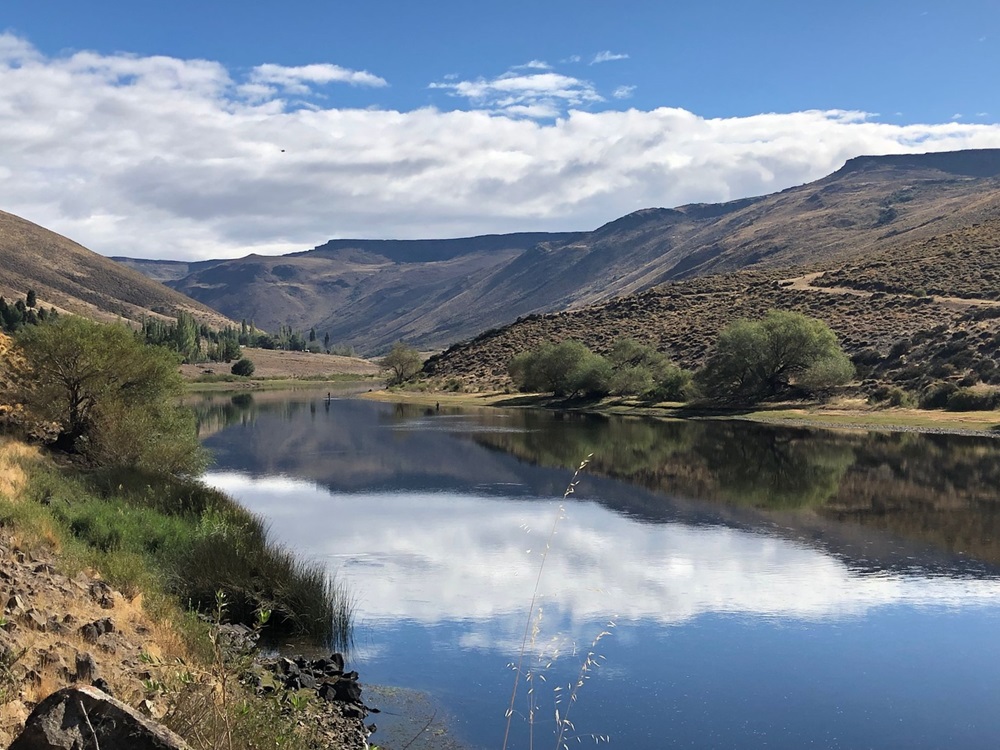
There were a few trout rising sporadically in the slow water along our bank, so we drove up the valley, trying to find a place where the current concentrated the rising fish together. We went up a way, but there were less rises upstream, so we returned to the pool with the fishers on the far bank. The patchy risers on our bank were looking better now that we had seen the empty water upstream, and I hurried down the bank to cast. The trout were rising only a metre or two off our bank. I had glimpses of rainbow trout shapes beneath the mirrored surface, and then we saw the small mayflies, lying spent. It was a spinner fall, the holy grail of dry fly fishing! I changed to a size 18 rusty spinner and started casting to the rises. That didn’t work, so I just left the fly in the right area and started getting eats, but I was having trouble with the timing of my strike. I had four takes before I hooked one, a hard fighting 18” rainbow which promptly swam towards me and escaped into the only small patch of bankside reeds – the dreaded juncus.
On our steep bank it was tough, and we watched the Frenchmen on the flat far bank hooking fish after fish on dry flies. I knew I should stop fishing long enough to walk upstream and cross at the head of the pool and then back downstream to join these guys, which would take about fifteen minutes, but I didn’t feel good about crowding them – and also, the rise could stop at any moment. In the end, I couldn’t drag myself away from the occasionally rising fish in front of me.
The rise finally stopped when the wind came up around 1pm and ruffled the surface. I had lost one and Carter had none. He had been unlucky; for some reason, there were fewer trout rising down where he was. Meanwhile the guys on the far bank had been hooked up almost continually.
We went back to camp and made our lunch, and then we drove on up the Rio Malleo to a stretch above camp. In a swift and turbulent run, Carter rose three respectable trout to a huge US salmonfly pattern. It was two inches long, made of pale foam, and complete with rubber legs and crystal-flash wings. It was the ‘works burger’ of dry flies – big and with the lot! Patagonian trout love huge dry flies, and they came up through more than a metre of water to eat, but unfortunately Carter didn’t hook them, despite seemingly doing everything right.
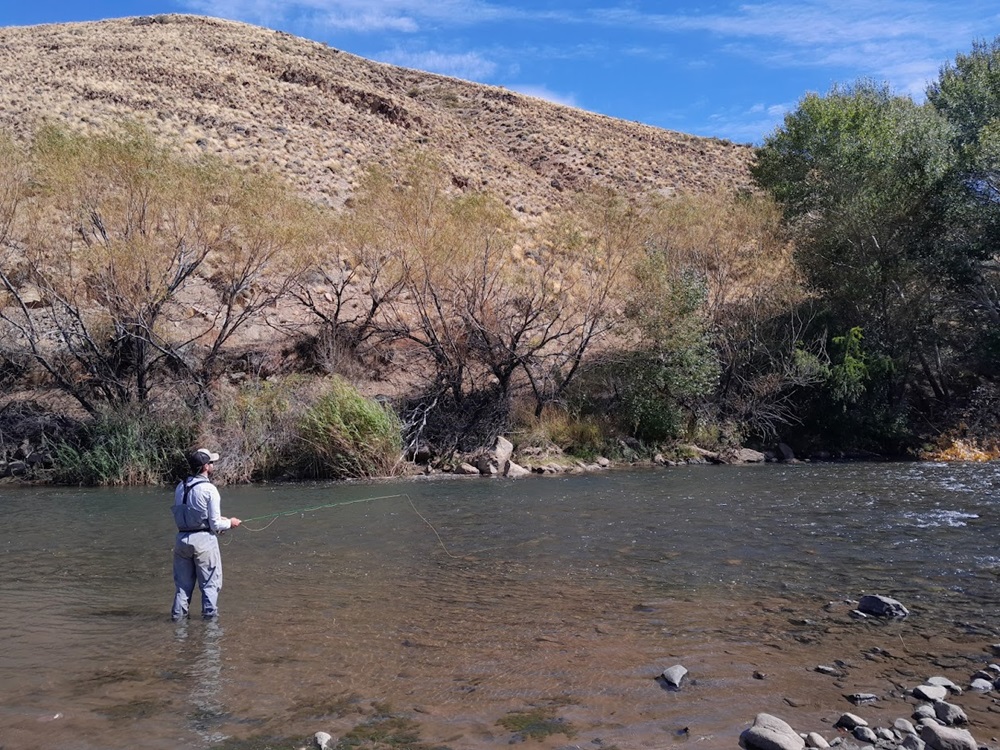
I walked upstream to a slow pool, sheltered by tall willows where a large brown around four pounds stopped rising and slipped away into the depths at my first cast. The trout were cruising the pools, and in the next reach it was almost impossible to spot them through the wind-ruffled surface in the lengthening shadows, so we eventually went back to camp. Carter fished the evening rise and lost a nice fish on his salmonfly. He was sure doing it tough with this huge dry.
Meanwhile, Ilda made us two dozen hot beef empanadas, cooking them on her wood stove. They were delicious and cost virtually nothing. She told us that she had found her puppy, hung up in the scrub by its collar. It had struggled all its strength away, and now slept on its mat by her house, too exhausted to eat, drink or even raise its head. Mauro and César also came in late; their day had been equally tough on the Rio Collón Curá.
Last Day
We got up early for our last full day of fishing, but Mauro and César were already up and hastily packing their silver caravan. Today they were towing it home to the capital, Buenos Aires, a journey of 2,200km in one go! They already looked wrecked after fishing and drinking until late every night and getting up early every morning to fish. Only their maté tea would keep them awake on their sixteen-hour non-stop journey across the hot pampa.
It looked like a windy day, so we chose to fish the smaller Rio Malleo and drove to where it entered the Rio Aluminé, parking near a fishing guide’s white ute. Carter waded down to fish the confluence while I walked up to start at the first pool. I nymphed confidently through the deep water of this swirling plunge pool and was surprised nothing came to my large gold bead caddis grub. I needn't have worried, for the next pool was wide and thigh deep, with a few fishy boulders in the head. In the knee-deep tail of the pool, my indicator dipped, and I tightened on a lively little rainbow. Encouraged, I continued to carefully prospect the opaque green water, first the bubble-line, and then the deeper swirling water along the edge of the willows. I picked up several more ‘bows here, the fish gradually getting larger as I moved up towards the deeper head of the pool. Carter appeared from downstream, still fishless, and his mood was not helped by hearing about the many fish I’d caught in this run. I sent him on upstream of me, hoping he would find some trout in the unfished water.
When I caught up with him around midday, he still hadn’t landed a decent trout. The downstream wind had become so strong that we couldn’t turn our leaders over, and it was a fiercely hot wind too. His stoicism was turning to despair, and later he would confide that he had had to sit down by the river to meditate and breath through the frustration. Sensing this, I immediately wound in, and resolved to get him onto a decent fish, playing guide.

I recommended fishing downstream with a small olive Woolly Bugger and a heavy split shot a foot above it. I selected a long bouldery run, with a strong current that was too deep to nymph easily: perfect streamer water. He started at the top, and soon Carter was standing thigh deep in the middle of the small river, swinging his way down the run like a steelheader. I sat in the shade of a willow and watched as he fished, while a group of alpacas – suitably woolly in preparation for the upcoming freezing winter – watched him from the far bank. He hooked four good rainbows in the deep green water, and when he landed one of them, the smile returned to his face.
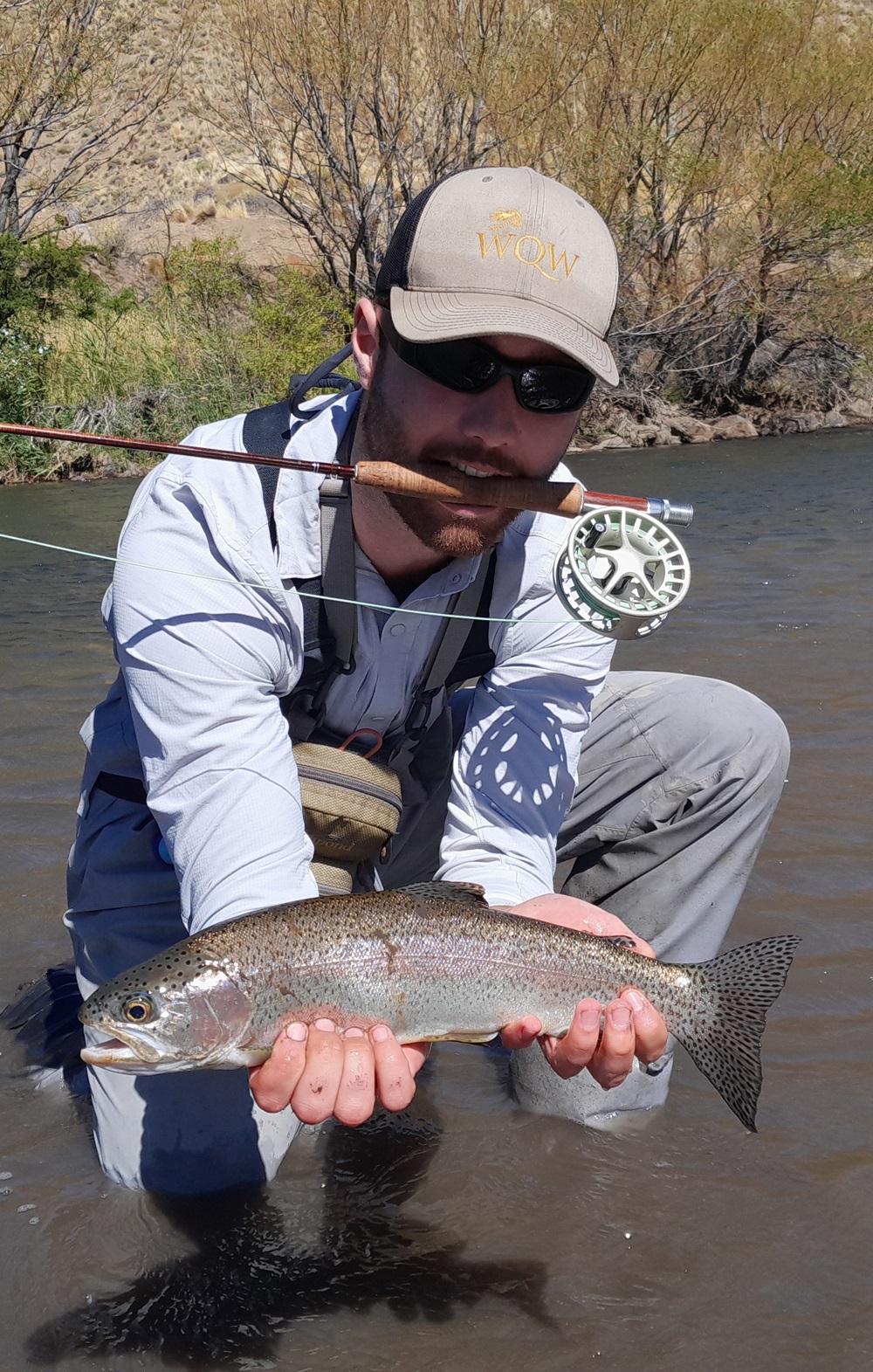
Trout in Patagonian rivers are keen on streamers, as they are used to eating pancoras – a kind of freshwater crab – and we could feel these in the bellies of the bigger trout.
I was happy that Carter was back in the game, and content that I could now stop playing guide and go back to fishing myself. Not too far upstream, I found a corner pool sheltered from the wind and caught a bunch of rainbows from it on the dry-dropper. The last fish was a lovely brown of 18 inches, which took the dry in a small, shady pocket right at the top of the run. This jack was already wearing its autumn colours, and its pancora-stuffed belly was as yellow as the post on my Parachute Adams.
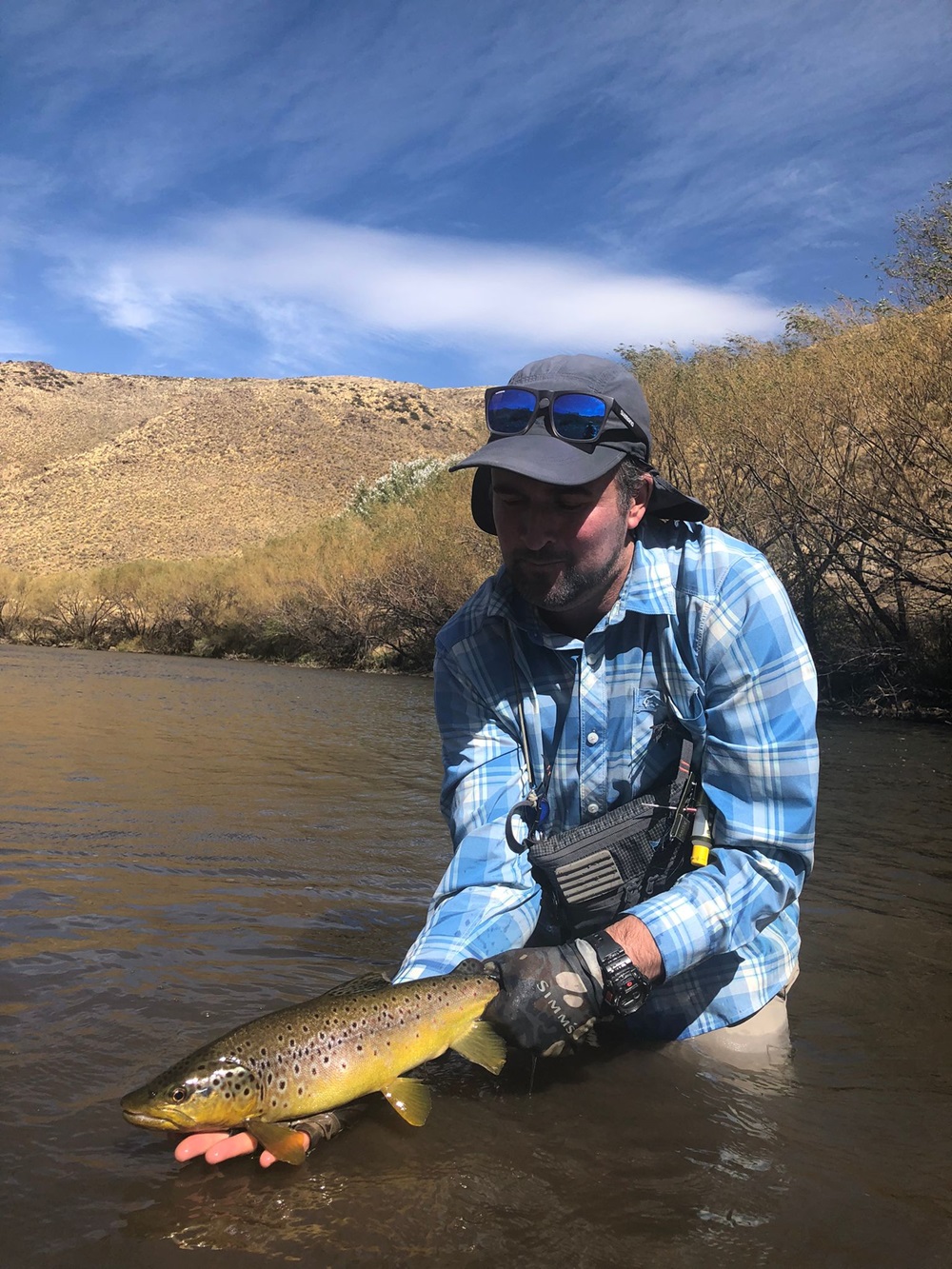
By mid-afternoon, the sun was beating down, and my face stung with the windblown silt. It was time to retreat to camp, so we cut across the paddocks, through the dry grass and bare earth to the gravel road. An ancient apple tree stood near the river, its profusion of shiny green leaves bursting forth from the old, gnarled wood like green fire. It had apples too, a small miracle in this parched landscape and we picked a few, the true ‘manzanitos’ or little apples of the camp's name. I enjoyed one as we walked up to the car through the afternoon heat.
After dinner, we drove up the valley in the hope of an evening rise, selecting a deep slow pool each. My pool was a mirror, its silver surface reflecting the last light long after the sun set behind the distant Andes. There was a sputtering caddis hatch, and I eventually connected with the most active fish in the slow tale of the pool, a chunky rainbow of 14 inches. There were bigger fish rising in the head of the pool, but I couldn’t get to them through the deep water, silt and willows. The rise stopped and I realised that I was getting cold, wet wading as the moon came up. I was a bit sad at the thought we were leaving the following morning, when there was still so much more to learn about this river. I slowly drove downstream and picked Carter up in the car headlights. He had finally caught a couple of nice ones on the dry, and just in time. He had switched to an American Adams variant called a Purple Haze - like the Jimi Hendrix song. I was really pleased for him.
Departure
In the morning, we had to leave. When we checked out, Ilda told us that it looked like the puppy was going to be okay. She also asked for our contacts. She had made friends with many of her guests from around the world, and still kept in touch with them. We left the camp and turned west towards the Andes, driving past gauchos on horseback, and when we reached the toll gate at the entrance to the reservation, we thanked the friendly young man for the great time that we had had on their land, fishing their river. I thought about how I would miss this dusty reservation, the slow pace of life and Ilda’s genuine hospitality.
Then we drove out into the wide and bright land once more.

FLYSTREAM FACTS:
El Manzanito Camping is on the Rio Malleo just upstream of its confluence with the Rio Alumine
My favourite guide in Bariloche who put us onto it, is Pablo Daniel – padagon1982@gmail.com
To follow Nick’s flyfishing travels and other writings, visit www.flyfishingtheworld.blogspot.com ,
facebook.com/mrnicholasmoody, or @mrnicholasmoody on Instagram











